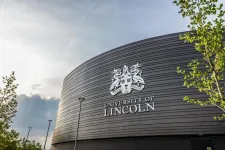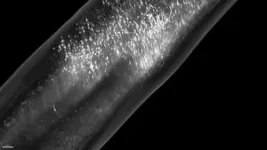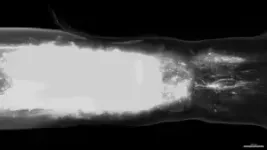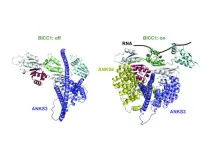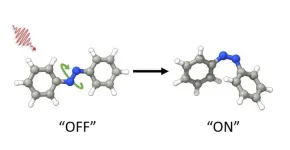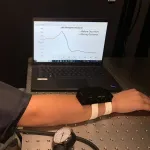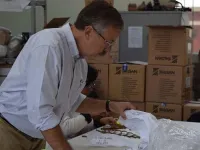(Press-News.org) A groundbreaking study, published today in Science, has provided new insights into the extensive impact of metal mining contamination on rivers and floodplains across the world, with an estimated 23 million people believed to be affected by potentially dangerous concentrations of toxic waste.
Led by Professors Mark Macklin and Chris Thomas, Directors of the Lincoln Centre for Water and Planetary Health at the University of Lincoln, UK – working with Dr Amogh Mudbhatkal from the University’s Department of Geography – the study offers a comprehensive understanding of the environmental and health challenges associated with metal mining activities.
Using a new georeferenced global database of 185,000 metal mines compiled by the team and employing a combination of process-based modelling and empirical testing, the research assessed the global scale of metal mining contamination in river systems and its repercussions for human populations and livestock.
The study modelled contamination from all known active and inactive metal mining sites, including tailings storage facilities - used to store mine waste - and looked at potentially harmful contaminants such as lead, zinc, copper, and arsenic, which are transported downstream from mining operations, and often deposited along river channels and floodplains for extended periods.
"Our new method for predicting the dispersal of mine waste in river systems worldwide provides governments, environmental regulators, the mining industry and local communities with a tool that, for the first time, will enable them to assess the offsite and downstream impacts of mining on ecosystem and human health,” said Professor Mark Macklin, who led the multi-disciplinary, international team behind the research:
“We expect that this will make it easier to mitigate the environmental effects of historical and present mining and, most importantly, help to minimise the impacts of future mining development on communities, while also protecting food and water security."
Released against the backdrop of growing demand for metals and minerals to feed the demands of the green energy transition, the new results highlight the widespread reach of the contamination, affecting approximately 479,200 kilometres of river channels and encompassing 164,000 square kilometres of floodplains on a global scale.
According to the findings released today, approximately 23.48 million people reside on these affected floodplains, supporting 5.72 million livestock and encompassing over 65,000 square kilometres of irrigated land. Due to a lack of available data for several countries, the team behind the study believe these numbers to be a conservative estimate.
Various pathways exist for humans to become exposed to these contaminant metals including from direct exposure through skin contact, accidental ingestion, inhalation of contaminated dust, and through the consumption of contaminated water and food grown on contaminated soils.
This poses an additional hazard to the health of urban and rural communities in low-income countries and communities dependent on these rivers and floodplains, especially in regions already burdened with water-related diseases. In industrialised nations in Western Europe, including the UK, and the United States, this contamination constitutes a major and growing constraint to water and food security, compromises vital ecosystem services, and contributes to antimicrobial resistance in the environment.
“Rapid growth in global metal mining is crucial if the world is to make the transition to green energy”, said Professor Chris Thomas who led the analysis and modelling,” Much of the estimated global contamination we have mapped is a legacy from the industrial era – rightly, modern mining is being encouraged to prioritise environmental sustainability. Our methods, which also work at local scales, add an important new approach in this process for which have set up an applied unit of our research centre ‘Water and Planetary Health Analytics’ to work with the sector.”
Professor Deanna Kemp from the University of Queensland’s Sustainable Minerals Institute, who was part of the team behind the study, called the results “sobering.”
“At a basic level, these findings remind us that mining can cause extensive downstream damage over long periods of time,” Kemp said. “Many people benefit from mining and metals, but we must do more to understand and prevent the negative effects on people who live and work in affected areas.”
ENDS
Notes to Editors:
For media enquiries, including interview requests, please contact Callum Thomas in the University of Lincoln Press Office on 01522 835746 or at pressoffice@lincoln.ac.uk.
More information, including a copy of the paper, can be found online at the Science press package at https://www.eurekalert.org/press/scipak/. Full study title: Impacts of metal mining on river systems: a global assessment
Additional quotes:
Professor Paul Brewer from Aberystwyth University commented: “These very significant findings demonstrate the scale of the threat posed to people, ecosystems, and the wider environment from metal mining activity across the world. For the first time, we have been able to establish that the number of people exposed to contaminant metals sourced from the long-term discharge of mining waste into rivers is almost 50 times greater than the number directly affected by acute tailings dam failures. The new modelling approach used in this study provides industry and regulatory agencies with a tool for assessing the potential downstream impacts of metal mining activity on human populations and the environment. This will benefit future generations as we will be able to develop better, data-informed strategies for identifying and managing land contaminated by metal mining.”
The full list of contributing Institutions:
Lincoln Centre for Water and Planetary Health, University of Lincoln, Lincoln, UK.
Innovative River Solutions, Institute of Agriculture and Environment, Massey University, Palmerston North, New Zealand.
Centre for the Study of the Inland, La Trobe University, Melbourne, Australia.
University of Namibia, Windhoek, Namibia.
Department of Geography and Earth Sciences, Aberystwyth University, Aberystwyth, Ceredigion, UK.
Environment & Sustainability Institute and Camborne School of Mines, University of Exeter, Penryn, Cornwall, UK.
Institute for Environmental Studies, Vrije Universiteit Amsterdam, Amsterdam, Netherlands.
Department of Inland Water Systems, Deltares, Delft, Netherlands Institute for Environmental Studies, Vrije Universiteit Amsterdam, Amsterdam, Netherlands.
Monash University Indonesia, Jakarta, Indonesia.
Centre for Development Support, University of the Free State, Bloemfontein, South Africa.
School of Natural Sciences, Bangor University, Bangor, Gwynedd, UK.
Centre for Social Responsibility in Mining, Sustainable Minerals Institute, The University of Queensland, St Lucia, Australia.
Ministry of Earth Sciences, Government of India, New Delhi, India.
About the University of Lincoln, UK:
The University of Lincoln is proud of its reputation for putting students at the heart of everything it does. We are rated in the top 40 UK universities for student satisfaction in the Guardian University Guide 2024 and in the top 50 UK universities overall in the Complete University Guide 2024. We hold a top five-star score in the QS Stars ratings system of global universities and are placed among the world's top 150 young universities in The Times Higher Education Young University Rankings 2023. Almost £400 million has been invested in our spectacular waterfront Brayford Pool Campus in the heart of Lincoln, providing a modern, student-centred environment for students from more than 100 nations. The University of Lincoln is known for a pioneering approach to working with employers and our unique relationships with companies such as Siemens Energy and the Lincolnshire Co-op demonstrate our innovative industry-engaged approach, which has been acknowledged through a series of national awards over the past decade. Through our research, we are striving to change society for the better. Working with regional, national, and international partners, our academics are engaged in ground-breaking studies that are challenging the status quo and making a tangible difference to the world around us. More than three quarters of our research was judged to be internationally excellent or world leading in the Research Excellence Framework 2021.
END
Global study reveals extensive impact of metal mining contamination on rivers and floodplains, suggesting need for new safeguards to address spike in demand for ‘green’ minerals
A groundbreaking study, published today in Science, has provided new insights into the extensive impact of metal mining contamination on rivers and floodplains across the world, with an estimated 23 million people believed to be affected
2023-09-21
ELSE PRESS RELEASES FROM THIS DATE:
Regeneration across complete spinal cord injuries reverses paralysis
2023-09-21
When the spinal cords of mice and humans are partially damaged, the initial paralysis is followed by the extensive, spontaneous recovery of motor function. However, after a complete spinal cord injury, this natural repair of the spinal cord doesn’t occur and there is no recovery. Meaningful recovery after severe injuries requires strategies that promote the regeneration of nerve fibers, but the requisite conditions for these strategies to successfully restore motor function have remained elusive.
“Five years ago, we demonstrated that nerve fibers can be regenerated across anatomically complete spinal cord ...
The dance of organ positioning: a tango of three proteins
2023-09-21
In order to keep track of their environment, cells use cilia, antenna-like structures that can sense a variety of stimuli, including the flow of fluids outside the cell. Genetic defects that cause cilia to malfunction and lose their sensory abilities can result in disorders known as “ciliopathies”, including polycystic kidney diseases; but they can also disrupt the correct asymmetric positioning of internal organs during embryonic development – what is known as “organ laterality”.
An example of such asymmetry is the heart, which is typically ...
Using harmless light to change azobenzene molecules with new supera molecular complex
2023-09-21
New discovery allows scientists to change the shape of azobenzene molecules using visible light, which is more practical and safe than previously used ultraviolet light. Azobenzenes are incredibly versatile and have many potential uses, such as in making tiny machines and improving technology as well as making light controllable drugs. This molecule can switch between two different forms by light. However, the two forms are in equilibrium, which means that a mixture present that prevents optimal use for applications. Being able to control them with visible light and enrich only one form opens up new possibilities for these applications, making them more efficient ...
Scientists regenerate neurons that restore walking in mice after paralysis from spinal cord injury
2023-09-21
In a new study in mice, a team of researchers from UCLA, the Swiss Federal Institute of Technology, and Harvard University have uncovered a crucial component for restoring functional activity after spinal cord injury. The neuroscientists have shown that re-growing specific neurons back to their natural target regions led to recovery, while random regrowth was not effective.
In a 2018 study published in Nature, the team identified a treatment approach that triggers axons — the tiny fibers that link nerve cells and enable them to communicate — to regrow after spinal cord injury ...
Conversations with plants: Can we provide plants with advance warning of impending dangers?
2023-09-21
Imagine if humans could ‘talk’ to plants and warn them of approaching pest attacks or extreme weather.
A team of plant scientists at the Sainsbury Laboratory Cambridge University (SLCU) would like to turn this science fiction into reality using light-based messaging to ‘talk’ to plants.
Early lab experiments with tobacco (Nicotiana benthamiana) have demonstrated that they can activate the plant's natural defence mechanism (immune response) using light as a stimulus (messenger).
Light serves as a universal means of daily human communication, for example the signalling at traffic lights, pedestrian ...
Chicago’s West Side is air pollution hotspot
2023-09-21
Three independent state-of-the-art datasets reveal that the West Side has more nitrogen dioxide (NO2) pollution than the rest of the city
Depending on the month, residents in this area experience 16 to 32% higher NO2 concentrations on average
By identifying hotspots, residents and policymakers can be confident about where to prioritize immediate interventions
EVANSTON, Ill. — The western edge of Chicago — including the North and South Lawndale, East Garfield Park, Archer Heights and Brighton Park neighborhoods — experiences up to 32% higher concentrations of nitrogen dioxide (NO2) air pollution compared to the rest of the city, ...
Biophysical Society announces 2024 Society Fellows
2023-09-21
ROCKVILLE, MD – The Biophysical Society is proud to announce its 2024 Society Fellows. This award honors the Society’s distinguished members who have demonstrated excellence in science and contributed to the expansion of the field of biophysics. The Fellows will be honored at the Biophysical Society’s 68th Annual Meeting, being held in Philadelphia, Pennsylvania from February 10-14, 2024. The 2024 Fellows are:
Rommie E. Amaro, University of California, San Diego, USA, is named a Biophysical Society Fellow for her work on developing methods to enable the simulation of biological molecules in situ and ...
Wearable optical device shows promise for detecting postpartum hemorrhage
2023-09-21
WASHINGTON — Researchers have developed a wearable optical device for early detection of hemorrhage during labor or after childbirth. This serious heavy bleeding can be hard to detect before it becomes an emergency and accounts for almost 30% of maternal deaths globally and just over 10% of maternal deaths in the United States.
Studies have shown that early diagnosis and treatment for postpartum hemorrhage is the best way to prevent deaths. The new device is designed to be worn on the wrist, where it uses laser speckle imaging to continuously ...
David Huang, M.D., Ph.D., receives Lasker Award for transformative imaging technology
2023-09-21
PORTLAND, Oregon -- The United States’ most distinguished biomedical research award is being given to Oregon Health & Science University physician-scientist David Huang, M.D., Ph.D., for co-inventing an imaging technology that routinely helps prevent blindness and is increasingly used to diagnose and treat conditions of the heart, brain, skin and more.
Huang is receiving the 2023 Lasker-DeBakey Clinical Medical Research Award as a co-inventor of optical coherence tomography, or OCT, the Albert and ...
New study reveals a long history of violence in ancient hunter-gatherer societies
2023-09-21
Violence was a consistent part of life among ancient communities of hunter-gatherers, according to a new study co-authored by a Tulane University researcher that looked for signs of trauma on 10,000-year-old skeletal remains from burial sites in northern Chile.
The study was published in the journal PLOS ONE.
Archaeological research has shown that interpersonal violence and warfare played an important role in the lives of hunter-gatherer groups over time. Still, many questions remain about the factors that influence such violence. The record of human populations in northern Chile extends across 10,000 years, providing a valuable opportunity to study patterns in violence over time.
John ...
LAST 30 PRESS RELEASES:
Injectable breast ‘implant’ offers alternative to traditional surgeries
Neuroscientists devise formulas to measure multilingualism
New prostate cancer trial seeks to reduce toxicity without sacrificing efficacy
Geometry shapes life
A CRISPR screen reveals many previously unrecognized genes required for brain development and a new neurodevelopmental disorder
Hot flush treatment has anti-breast cancer activity, study finds
Securing AI systems against growing cybersecurity threats
Longest observation of an active solar region
Why nail-biting, procrastination and other self-sabotaging behaviors are rooted in survival instincts
Regional variations in mechanical properties of porcine leptomeninges
Artificial empathy in therapy and healthcare: advancements in interpersonal interaction technologies
Why some brains switch gears more efficiently than others
UVA’s Jundong Li wins ICDM’S 2025 Tao Li Award for data mining, machine learning
UVA’s low-power, high-performance computer power player Mircea Stan earns National Academy of Inventors fellowship
Not playing by the rules: USU researcher explores filamentous algae dynamics in rivers
Do our body clocks influence our risk of dementia?
Anthropologists offer new evidence of bipedalism in long-debated fossil discovery
Safer receipt paper from wood
Dosage-sensitive genes suggest no whole-genome duplications in ancestral angiosperm
First ancient human herpesvirus genomes document their deep history with humans
Why Some Bacteria Survive Antibiotics and How to Stop Them - New study reveals that bacteria can survive antibiotic treatment through two fundamentally different “shutdown modes”
UCLA study links scar healing to dangerous placenta condition
CHANGE-seq-BE finds off-target changes in the genome from base editors
The Journal of Nuclear Medicine Ahead-of-Print Tip Sheet: January 2, 2026
Delayed or absent first dose of measles, mumps, and rubella vaccination
Trends in US preterm birth rates by household income and race and ethnicity
Study identifies potential biomarker linked to progression and brain inflammation in multiple sclerosis
Many mothers in Norway do not show up for postnatal check-ups
Researchers want to find out why quick clay is so unstable
Superradiant spins show teamwork at the quantum scale
[Press-News.org] Global study reveals extensive impact of metal mining contamination on rivers and floodplains, suggesting need for new safeguards to address spike in demand for ‘green’ mineralsA groundbreaking study, published today in Science, has provided new insights into the extensive impact of metal mining contamination on rivers and floodplains across the world, with an estimated 23 million people believed to be affected
